 |
New York
Architecture Images-Upper West Side
Dutch Collegiate Church |
|
architect
|
Robert Gibson |
|
location
|
West End Avenue at 77th
Street. |
|
date
|
1891-2 |
|
style
|
Colonial
Revival |
|
construction
|
|
|
type
|
Church |
|
images
|
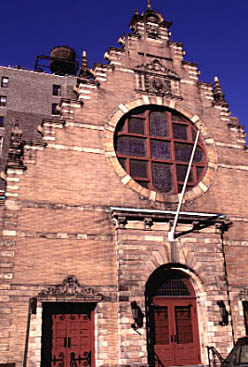 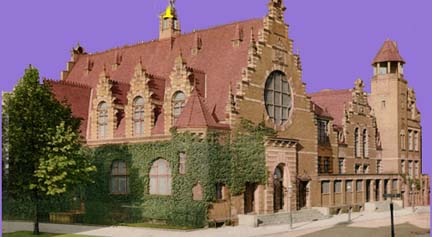 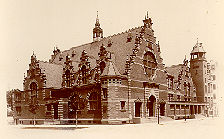 |
|
|
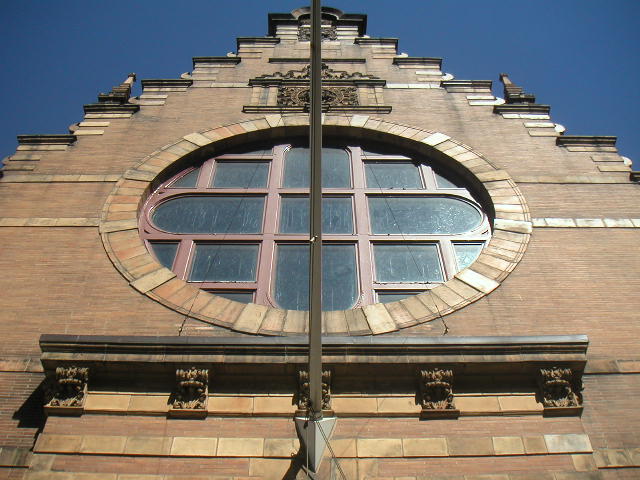 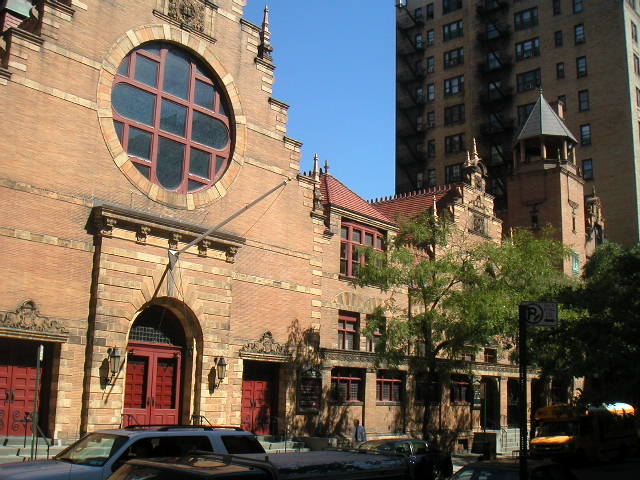 |
|
|
 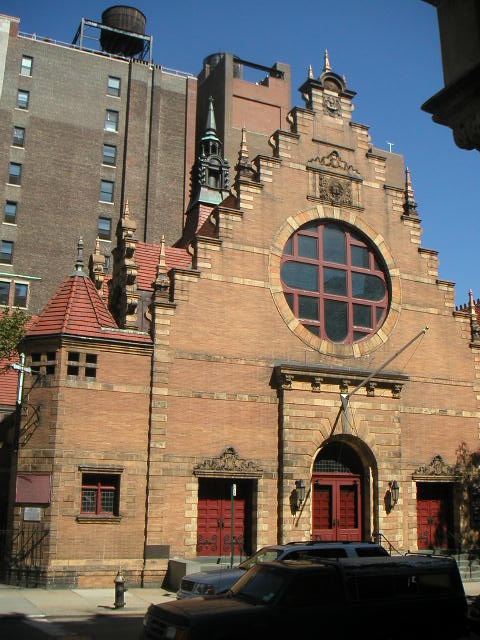 |
|
|
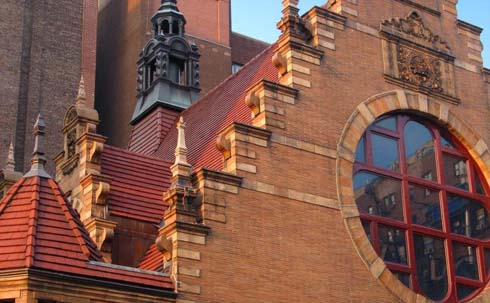 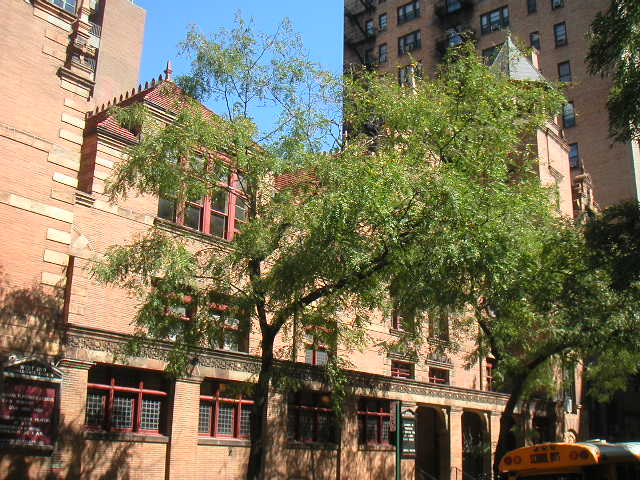 |
|
notes
|
This building
housed a congregation of the Dutch Reformed Church, a descendent of the
original settlers' church in New York. As such, the Dutch Revival building
links the European traditions of a Dutch congregation founded in New
Amsterdam with the new spirit of American metropolitanism.
The clear separation of functionally
distinct building elements, along with the unique use of colors and
materials attracts the attention of passersby. The church's stepped
gables, thin brick walls, and colorful stone, terra-cotta and Dutch tile
ornament consciously draw upon Dutch traditions which were popular at
the time. The most immediate source for the building is a 17th century
meat market in Haarlem, The Netherlands.
The church, erected in 1891, and the last
one dedicated, is the West End Church, on West End Avenue and
Seventy-seventh Street. This was built to accommodate the large number
of families who were moving into that section of the city. The Flemish
style of architecture is employed and is historically appropriate. On
the cornerstone is inscribed: "Organized A. D. 1628—Erected 1891". The
interior is particularly beautiful. It is a good example of Dutch
architecture adapted to modern uses: the roof is of heavy dark timber
beams, the supporting arches rest on pillars of purple Knoxville marble.
The pulpit is a handsome piece of carved oak, the panels showing the
coat-of-arms of the Reformed church, and the seal of the Collegiate
Church. The armorial window at the south end is worthy of detailed
examination
A Beautiful Historic Building
As the West Side expanded, criticism was made of the lack of uniformity,
and developers were urged to keep the character and scale of a group of
buildings similar. The Romanesque style had become overused and the
architectural firm of McKim Mead & White, attempting both to attract old
Knickerbocker families and give the community a sense of history,
initiated a revival of Dutch Colonial on the Upper West Side. Many
buildings on West End Avenue and side streets were built in this style.
The design of West End Church was chosen not only to reflect the Dutch
history of the Collegiate Church, but because it was part of an urban
trend at the time. Architect Robert W. Gibson styled the church after
the 1606 Vleeshal in Haarlam, The Netherlands.
The church yearbook of 1892 describes the
new building:
The style of architecture is Dutch,
modeled upon the old buildings of Haarlam and Amsterdam. This style has
the picturesque qualities of the Gothic with more originality and is
historically very appropriates. The materials are a long thin brick of a
Roman pattern and brown in color, trimmed freely with quoins and
blockings of buff terra cotta. Some very picturesque panels carved with
the coats-of-arms of the church and of past benefactors are also in
terra cotta. The pulpit is large and of octagonal shape. Its handsome
base is of carved oak, the panels showing the coat-of-arms of the
Reformed Church and the seal of the Church. The carved oak pulpit chairs
are rich examples of the Old Dutch style. (Decoratively the church is
actually Renaissance Revival in style.)
In the large circular window in the south
gable of the church is placed an armorial window which exhibits the
armorial bearings of the various Dutch Provinces forming the Union of
Utrecht, also the heraldic symbols of the United States and the State
and City of New York, thereby setting forth the common origin and union
of the parent stem and American branch of the Collegiate Church.
Over the next several decades, contributors
donated the various windows we see today, three of which are from the
Tiffany studios. |
|
|
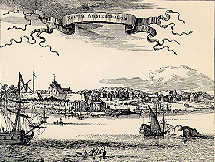
History- the Dutch
period
Probably the first
Christian religious services in New Netherland were conducted by
comforters of the sick (Krankenbezoekers), who were sent and supported
by the Dutch West India Company. So far as is known, the earliest of
these comforters was Bastien Jansen Krol, who arrived with the first
colonists under Cornelius May and founded the first Dutch Reformed
Church in North America at Fort Orange (Albany) in 1624. After a few
months at Fort Orange, Comforter Krol returned to Holland to obtain a
minister for New Netherland. However, the settlement was not considered
large enough to warrant a minister, and Bastien Krol returned to New
Netherland with power to baptize and marry, provided he used the liturgy
of the church in his services. When Governor Peter Minuit arrived in
1626 to take charge of the colony, he ordered that the settlement should
center about the southern portion of Manhattan Island. Soon after Peter
Minuit's order, Comforter Krol left Fort Orange to become the first
comforter at New Amsterdam. He was joined in July 1626 by Jan Huygens,
who had been commissioned as a "Ziekentrooster", or a seeker out of the
sick.
The comforters of the sick were required to read prayers every morning and
evening, as well as before and after meals, to instruct and comfort the
sick, to exhort those who required or requested exhortation, and to read
chapters from the Bible and sermons of an ordained minister. The
comforters were empowered to baptize and marry, but could not administer
Holy Communion. A special form of service was prepared for them to
read. At a horse mill built by Francis Molemaecker in 1626, the
settlers attended divine services in a room especially constructed to
accommodate the congregation.
In 1628, the Dutch West India Company sent the Reverend Jonas Michaelius
as the first ordained minister to New Netherland. Dominie Michaelius was
commissioned by the Classis of Enkhuysen, but , shortly after his
commission, the supervision of ecclesiastical affairs in the colonies of
the Dutch West India Company passed to the Classis of Amsterdam. The
formation of the Reformed Dutch Church on Manhattan Island is described
in a letter from Dominie Michaelius, in which he declared that "from the
beginning we established the form of a church", the government of which
consisted of Michaelius as pastor, Peter Minuit as elder, and Jan
Huygens as deacon. This first consistory, or local church government,
in Manhattan was responsible to and under the control of the Classis of
Amsterdam.
Dominie Michaelius had a three-year contract with the Dutch West India
Company, and upon his return to the Netherlands, he was succeeded by
Dominie Everardus Bogardus, who arrived with Director Van Twiller in
1633. Shortly after his arrival, the meeting place above the horse mill
was replaced by a frame building with a gambrel roof, but without a
spire or belfry. The dissatisfaction of the people of the colony with
this building, combined with the fact that Director Kieft, the successor
of Van Twiller, desired to leave a monument to himself, led to the
building of a new church in 1647. This was the famous
church-in-the-fort, built partly by subscriptions and partly from
pledges raised during the wedding feast of the daughter of Dominie
Bogardus.
In 1647 Director Kieft and Dominie Bogardus resigned their posts in New
Netherland. In the same year, Reverend Johannes Backerus stopped at New
Netherland, on his way to Holland. He was persuaded to stay and supply
the church-in-the-fort, until 1649, when Dominie Johannes Megapolensis
was called from Rensselaerwyck (Albany) to assume charge at Manhattan.
This zealous preacher gave the rest of his life to the development of
the Reformed Dutch Church in New Amsterdam.
The post left vacant by Director Kieft in 1647 was filled by Peter
Stuyvesant. From him the Reformed Dutch Church, which was the state
church in New Netherland, received great aid. Under his rule, laws
previously enacted to compel Sunday observance were rigorously enforced.
In addition, Stuyvesant and his council enacted new laws in the
interest of the church. In 1647 a law was passed restricting the sale
of liquor and the frequenting of taverns on the Lord's Day. In 1657 a
law prohibiting all labor on the Sabbath was enacted. A law of 1664
required schoolmasters to catechize their children every Wednesday in
the presence of the elders and ministers of the church.
Stuyvesant was disturbed by the question of religious freedom. The
Directors of the Dutch West India Company had ruled in 1640 that "no
other religion shall be publicly admitted in New Netherland except the
Reformed", and Peter Stuyvesant was eager to carry out this ruling.
English settlers, adhering to Presbyterian doctrines, had been given
religious freedom by Director Kieft in 1644. The continued increase in
their numbers caused Stuyvesant and Dominie Megapolensis to request that
the Classis of Amsterdam send over a minister to preach in English to
these settlers. In response, the Reverend Samuel Drisius, formerly
pastor of the Dutch Church in London (Austin Friars), and capable of
preaching in Dutch, English, French and German, was sent to New
Amsterdam to become the colleague of Dominie Megapolensis. The
collegiate system, whereby two or more congregations are controlled by a
single consistory, was thus inaugurated in the Dutch Reformed Church in
New Amsterdam, and is still in existence.
Although the English Calvinists did not trouble Stuyvesant, the coming of
the Quakers, Jews, and Lutherans did. Stuyvesant and his council
enacted severe laws against them, which, if effectively enforced, would
have destroyed their freedom of worship. The Lutherans carried a
protest to the Dutch West India Company. The directors of that body
rebuked the fiery Stuyvesant for his undue severity and ordered him not
to enforce the laws prohibiting worship by Lutherans and other sects.
Under Peter Stuyvesant, the services of the Reformed Church on the Sabbath
were highly ceremonious. All labor was required to cease, and the
family groups, clad in their finest raiment, journeyed from all parts of
the settlement to the church services. Both the schout of the town and
the town crier made their rounds to preserve the peace and to enforce
the liquor laws. The service was preceded by a parade of dignitaries,
led by the marshal of the council, who marched down the aisle before
Governor General Peter Stuyvesant. The governor was followed by the
provincial secretary, the burgomasters and schepens, all of whom sat on
the velvet cushions carried by the town marshal from the State House to
the place of worship.
The service was in the Dutch language. A "fore singer" or clerk sat in a
desk under the pulpit, or in a deacon's pew, and began the service by
admonishing the people to "Hear with reverence the Word of the Lord".
He then read the Commandments and announced the psalm to be sung.
During the psalm, the minister entered the church, knelt in prayer, and
ascended the high pulpit. From this elevation he preached a sermon,
usually lasting three hours. If he exceeded this length of time he
would be admonished by three raps of the clerk's cane on the floor. At
the end of the service, the clerk inserted in his staff the notices to
be read and handed them to the minister. After these were read, the
pastor admonished the congregation to be of help to the poor. The
deacons then collected the offerings in leather bags which hung at the
end of long poles; a hymn was sung, and the congregation then filed out.
Meanwhile, the Reformed Church in New Amsterdam continued to grow.
Branches of the Reformed Church developed in Flatbush, New Amersfort,
Brooklyn, Long Island, and Harlem. Reverend Johannes Thadeus Polhemus
was the first pastor of the three congregations on Long Island, but he
was soon replaced by the Reverend Henricus Selyns, who became pastor at
Brooklyn in 1660, and also minister at the chapel in Stuyvesant's
bowery, now the site of St. Mark's Episcopal Church. The congregations
on Long Island were also becoming stronger. The minister to the three
churches was assisted by a "voorlesor" or clerk, who, besides being
assistant minister (reading sermons), taught school, dug graves, rang
the church bell, led the singing, and was also to serve as messenger to
the consistory. This individual was an important figure in the early
Reformed Churches of New Amsterdam, as most of the churches could not
support a minister themselves and were supplied by one or two ministers
serving a group of churches.
|
|
|
British rule 1664-1783
The seizure of New
Netherland in 1664 by the English fleet under Governor Nicholls arrested
the development of the Reformed Dutch Church in New York. Since fewer
Dutch immigrants came to New York, the increase of communicants in the
Church was seriously curtailed. The gravest problem facing the Reformed
Church was that of supporting the three ministers and maintaining the
churches, since financial support by the Dutch West India Company had
been cut off.
Another problem created by the English seizure of New Netherland was the
question of ecclesiastical sovereignty. Although the communicants of
the Reformed Dutch Church in New York were now English subjects, the
church still acknowledged allegiance to the Classis of Amsterdam. It
was more than a century before a solution was found for this problem.
In the main, the Dutch Church in New York was well treated by the English.
The articles of surrender, in 1664, had provided that "the Dutch here
shall enjoy the liberty of their consciences in Divine Worship and
Church discipline." The same document also protected the Dutch Churches
by providing that no public buildings were to be molested. When the
Dutch were told to swear allegiance to the English government, they
refused until an appendix was added to the oath stating that "it was
conformable to the articles concluded on the surrender of this plan."
Freedom of religion was further guaranteed under the Duke's Laws.
To solve the problem of supporting the Dutch Church, the members of which
constituted the larger part of New York's population, Governor Nicholls,
in 1665, directed the city authorities to levy a tax to pay unpaid
salaries of the Dutch clergymen. In 1670, Governor Lovelace guaranteed
a salary to any Dutch minister who would come to New York and assist the
aged Dominie Drisius. This offer brought Dominie William Van
Nieuwenhuysen, the first minister selected by the Classis of Amsterdam
after the surrender of the province. The Dutch reciprocated English
friendship by allowing the Anglicans to use the church-in-the-fort after
the Dutch services had been completed.
The friendly attitude of the English government toward the Dutch Church
was disturbed somewhat when the Dutch element in the colony repeatedly
defeated all attempts to establish the Church of England in New York.
After reoccupying New York in 1674, the English governors redoubled
their efforts to establish the Anglican faith, but, in the main, were
unsuccessful. In 1691, William of Orange granted the colonists the
right to elect an assembly to enact legislation. This assembly,
preponderantly Dutch, became the bulwark of the Dutch Reformed Church in
New York. Requests by governors of the colony that an act be passed
establishing the Church of England were continually denied by the
assembly.
In the midst of these attempts to establish the Anglican Church, the
Reformed Church continued in its work. It completed a new church in
1694, and left the church-in-the-fort to the English chaplain, who
conducted services there. Under Dominie Selyns the Church conducted a
fight for a charter from 1688 to 1696, and, on May 11, 1696, that
charter, drawn up by the best legal talent in the colony, was signed by
Governor Fletcher.
The Charter of 1696 was the first granted to any religious body by the
English government in New York. By this charter the Reformed Dutch
Church in New York, now known as the Collegiate Church, was incorporated
under the name of "The Minister, Elders, and Deacons of The Reformed
Protestant Dutch Church of the City of New York". The members of the
Church were given freedom of religion; perpetual succession of ministers
in the church was assured; and the Church's property was confirmed to
it. The charter, in great detail, gave the Church a right to elect
officers, call ministers, assess members for the maintenance of the
Church, sell or rent property, have a private income, and to sue and be
sued.
The possession of a charter did not completely protect the Dutch Church
from English Governors, particularly Governor Cornbury. Attempts on the
part of the latter to control the appointment of a minister to the Dutch
churches in Long Island led in 1706 to the migration of many members of
the Dutch Church in New York to New Jersey. They settled in the Raritan
and Millstone valleys of New Jersey, and founded many churches in a
section later known as "The Garden of the Dutch Church". In spite of
these temporary setbacks, at the opening of the eighteenth century, the
Dutch Church in New York was the largest as well as the oldest religious
group in the colony.
As the Church developed and required new ministers, the problem of
ecclesiastical control grew larger. The Classis of Amsterdam still
examined and licensed all ministers in the Reformed Church in America,
and arbitrated all ecclesiastical disputes. The demand for new
ministers to supply the American churches could not be met by the
Classis of Amsterdam, as the salaries were small, and prospects of
preaching in the wilderness were not alluring. The churches of America
sent some of their promising men to the Netherlands, but this was not a
solution to the problem of supplying a ministry for America. Accordingly
a movement developed in the American Reformed Dutch Church for freedom
from Dutch control.
One step in that direction was the formation, in 1747, of a Coetus,
permission for the institution of which was obtained from the Classis of
Amsterdam. This Coetus was a national church body composed of a minister
and elder from each church. Its function was to consider ecclesiastical
matters which lay beyond the sphere of individual churches, and which
formerly had been dealt with by the Classis of Amsterdam. For
consideration of local questions, the Coetus was divided into local
bodies, called "circles"; the churches of New York City, Long Island and
Poughkeepsie comprised the Circle of New York.
Although the organization of the Coetus was an important step toward
independence for American churches, it did not solve their problem of
supplying ministers. In that matter, the Church was entirely
subordinate to the Classis of Amsterdam, which retained the power to
license candidates for the ministry.
Opposition to this limitation led to a struggle between two groups in the
Reformed Dutch Church in America; the Coetus group, which sought the
power to license and ordain its own ministers, and the Conferentie
group, which favored subordination to the Classis of Amsterdam. The
lack of unity in the Dutch Reformed Church resulted in the dissolution
of the Coetus in 1754.
The conflict in the Church continued unabated until the question of
installing an English speaking minister in the Reformed Dutch Church
arose. The importance of this problem overshadowed the dispute between
the Coetus and the Conferentie groups.
A strong movement for an English speaking ministry in the Dutch Church of
New York had arisen by the middle of the eighteenth century. English
was the language of the courts in New York and was spoken by the young
people at their places of work. After having previously denied several
requests by communicants for an English speaking ministry, the New York
Church, with the concurrence of the Classis of Amsterdam, selected
Dominie Archibald Laidlie, in 1763, to preach in English. This
innovation was opposed by a group of conservative Dutch, who appealed to
the Classis of Amsterdam to forbid English sermons in the Church on
Manhattan Island, but that body refused to do so.
While studying for the ministry in the Netherlands, John H. Livingston
presented to the Classis of Amsterdam a plan of union for the American
Reformed Dutch Church. According to this plan, each Reformed Dutch
Church in America was to form a part of a local group called a coventus,
similar to the old circle. Delegates from each coventus were to compose
a general Coetus, a national body which was to meet each year. This
General Coetus was to have power to examine and ordain prospective
ministers, provided that the Classis of Amsterdam was notified of these
proceedings. The bond between Holland and America was not to be broken,
nor were the American churches to be allowed the use of the names
Classis and Synod.
Upon completion of his studies in the Netherlands, Dr. Livingston, a
graduate of Yale College and the last minister called to a New York
church who had studied and received his license in Holland, accepted a
call of the Manhattan Consistory to fill the pulpit of a new church.
Under his direction, a conference was held in New York at which the
plan of union was adopted. Slight modifications were made in the
proposed plan, such as the substitution of the term "general body" for
coetus and "particular body" for coventus. Upon approval of these
modifications by the Classis of Amsterdam, the American Reformed Church
now became free of Dutch control.
The Church, in the main, supported the American Revolutionary movement,
and two of the Church's prominent ministers were outspoken champions of
the colonists' cause. When the British troops occupied New York City,
after the Battle of Long Island, the pastors of the Reformed Church in
New York City fled for safety, leaving their congregations without
services from 1776 to 1783. The British commandeered for their use the
Reformed Dutch Churches on Manhattan Island. The New (later Middle)
Church was first used as a prison, and later as a riding academy. The
North Church was stripped of its furniture and used as a hospital. A
group of Loyalist church members was allowed to use the old Garden
Street Church, where they listened to Dominie Lydekker, a Loyalist
minister from New Jersey. In 1779, the Garden Street Church was also
used as a hospital, and Dominie Lydekker accepted the offer of Trinity
Corporation to use St. George's Chapel.
|
|
|
American rule 1783-1892
Dr. Livingston was the only
one of the four ministers of the Collegiate Church who had been in
service at the outbreak of hostilities to return to his charge in New
York City. Immediately after his return to the Garden Street Church on
December 7, 1783, he set to work to clarify the legal status of his
church, gather his scattered congregation, and rebuild the churches.
Despite the fact that all charters which had been granted by the English
government to ecclesiastical bodies were guaranteed in the Constitution
of 1777, the Reformed Dutch Church petitioned the legislature for a
ruling on its 1696 charter. In 1784 the legislature reaffirmed the
charter of 1696 granted to the Reformed Church in New York City, thus
putting at rest any doubts concerning the charter's validity. By this
reaffirmation, the Collegiate Church retained its original powers,
except that of assessing members to pay for Church salaries and repairs.
In 1784, the state legislature also passed a general act for the
incorporation of religious societies of all denominations. This act
enabled the religious bodies of the state to appoint trustees to act as
a body corporate and to assume charge of any church's finances. Prior
to this time, the finances of the Dutch Reformed Church had been managed
by the minister, elders, and deacons of each church.
Since the Dutch Reformed Church desired the continuance of this method of
financial organization, it petitioned the state legislature to limit the
application of the law of 1784. Accordingly, in the second section of
an act of 1813, which was concerned with religious liberties, a clause
was inserted "provided always that nothing therein contained shall be
construed in any manner to impair or alter the rights of any chartered
churches within this state." This gave legal sanction to the traditional
manner in which the Church had administered its finances.
The second problem that confronted Dr. Livingston was that of reviving the
Church and rebuilding its edifices. The Garden Street and the Old North
Churches were quickly repaired, and the Middle Church was completely
rebuilt. Yet, although the churches were ready for services, the
congregations did not attain their pre-war size. In fact, from 1785 to
1800, the membership of the Reformed Church in New York City continually
declined, and no new members were added during the 1790's. Charles
William Janson, an Englishman traveling in the United States during this
period, recorded in his diary that many of the Dutch in New York City
were attending the Episcopal Church. The people had been without
services for so long that it was a difficult task to draw them into the
Church again. But the Reformed Dutch Church in New York City, under the
guidance of Dr. Livingston, persevered in its task of rebuilding the
Church. In 1787, the Collegiate Consistory called Rev. William Linn,
formerly a Presbyterian, to aid Dr. Livingston and, in 1789, Rev.
Gerardus A. Kuypers was called to preach in Dutch. The churches in
Queens County not only endeavored to repair the damage done to the
Church during the war, but also called Dominie Van Nest in 1785. Under
his leadership, the Reformed Churches in Queens prospered. In the early
part of the nineteenth century the four Queens churches discarded the
collegiate system, each church calling its own pastor.
The Collegiate Churches of Kings County, likewise disrupted by the war,
united in calling the Rev. Martinis Schoonmaker. Under his guidance the
congregations soon attained their pre-war size. The churches of
Brooklyn, New Utrecht, Flatbush, and Bushwick prospered to the extent
that, by 1824, they too discarded the collegiate system.
Soon after the establishment of an independent America, the Dutch Reformed
Church reorganized its government. The names Synod and Classis were
substituted for the names General Body and Particular Body,
respectively.
A committee was appointed to translate and publish the doctrines of the
Church and the articles of Church government. In addition, 73
explanatory articles were added to the articles of Church government,
the added articles applying particularly to the American Reformed
Church. The work of this committee was approved by the Reformed Dutch
Churches in America and, in 1792, became the first constitution of the
Church.
Under this constitution, the Church subscribed to the doctrines of the
Apostles', the Nicene, and the Athanasian Creeds, the Belgic Confession,
the canons of the Synod of Dort, and the Heidelberg Catechism. The
government of the Church was organized into consistories, classes,
particular synods, and a General Synod. The Consistory, the basic local
government in the Church, was composed of the elders, the deacons, and
the minister of each church. The Classis was composed of all ministers
in a district, plus an elder from each Consistory. The Classis
functioned as the body of "general superintendence" over churches within
its boundaries and had the power, in conjunction with the Particular
Synod, to examine and license students for the ministry. The Classis
was the first branch of the appellate division in the Reformed Dutch
Church to which the individual churches might go to seek advice and
orders. The Particular Synod composed of four ministers and four elders
from each classis was to superintend the affairs of the various classes
within its boundaries. Above these bodies was the General Synod, whose
members, nominated by the Particular Synod and elected by the various
classes, constituted the final court of appeal in the Church. To the
General Synod was also delegated the important power of formulating
Church policies.
Since 1792, the organization of the Church as outlined above has remained
substantially unchanged. Some modifications in the geographical
boundaries of classes have been made, but the articles concerning the
individual churches have remained unaltered. In 1793, the Reformed
Dutch Churches of Queens, Richmond, Kings Counties, Manhattan, and
Harlem were organized into the Classis of New York. In 1800, when the
Particular Synods of the Church were organized, the Classis of New York
was grouped with four classes into the Particular Synod of New York.
Thus by 1800, the independent government of the Reformed Dutch Church
in the United States was formed. The official correspondence between
the Classis of Amsterdam and the American Church had come to an end.
The period of reorganization over, the Reformed Dutch Church in New York
now settled down to an era of continued growth. New congregations were
organized and new church edifices built, the Reformed Dutch Seminary in
New Brunswick supplying the ministers. As the city spread out, other
Reformed Dutch Churches, independent of the Collegiate Churches, were
organized. The Reformed Protestant Dutch Church at Greenwich was
organized in 1803, and in 1806, the Bloomingdale Reformed Dutch Church
received a charter. In 1808, the North West Reformed Dutch Church
received a charter, and in 1810, the Reformed Church in Harlem also
received one. In 1812, the Old Garden Street Church withdrew from the
Collegiate Church and obtained a charter as an independent church. This
growth was evidenced in other parts of what is now Greater New York,
particularly in Brooklyn. In 1824, Brooklyn abandoned the collegiate
system, and by 1836, it had two Church organizations of the Dutch
Reformed faith. By 1813, the churches of Long Island were important
enough to warrant the formation of a Classis of Long Island. In New
York City, a movement to further to divide the Classis of New York was
successful and, in 1828, the Classis of South New York was organized.
Throughout the early part of the nineteenth century, the Classes of Long
Island and New York continued to report favorably about their churches
and the work they were doing. In 1822, the "Missionary Society of the
Reformed Dutch Church" was organized, with offices in New York City. In
the course of its existence, it conducted active missionary activity in
the newly settled regions. In 1831, this society was absorbed by the
Board of Missions, which also had its offices in New York City. It was
this Board which aided in the establishment of Reformed Dutch Churches
in Michigan, Iowa, Wisconsin and Illinois. The name of this organization
subsequently was changed to the "Board of Domestic Missions of the
General Synod".
The steady progress of the Reformed Church in New York continued until
after the Civil War. Sunday schools for children were opened. The
inauguration of the Fulton Street Prayer meeting aided in bringing the
Church to the attention of the people of lower New York. The increase in
the number of churches on Long Island was large enough to warrant their
being divided into two classes: North and South Long Island. An era of
prosperity seemed in store for the Reformed Church in New York.
However, after the close of the Civil War, the Reformed Dutch Churches in
Manhattan experienced a slow decrease in membership. The basic reason
for this condition was the location of the churches on lower Manhattan
Island.
As the immigrants poured into New York City, the old members of the
Reformed Dutch Church moved to Long Island, Staten Island, and upper
Manhattan. By 1875, various churches began to refer to this downtown
location as the cause for the decrease in their membership. In 1887,
the Classis of New York, in its report to the Particular Synod, devoted
a good deal of attention to this condition.
The decline in Church membership in Manhattan was partly counterbalanced
by an increase in the membership of the Reformed Dutch churches in the
North and South Classes of Long Island. To meet the problem in
Manhattan, in 1892 the Collegiate Church opened two new churches: the
Middle Church and the West End Church, the latter in the
ultra-fashionable area of 77th street. By the turn of the century most
of the Reformed Dutch Churches of Manhattan Island had moved uptown.
The Reformed Dutch Church in Greater New York is strongest in the two
Classes of Long Island. The church on Long Island has surpassed the
church in New York in membership, as well as in the number of churches
built. Thus, in 1935, Long Island had 52 Reformed Dutch Churches and a
combined membership of 13,552, while there were only 28 churches with a
membership of 8,858 in the New York Churches within the Classis of New
York. Today, the Church which Dominie Michaelius founded in 1628 with
the "fully fifty communicants" has spread its influence not only to the
territory surrounding Manhattan, but also to such remote areas of the
world as Amoy, China and Arcot, India.
|
|
|
There was a congregation
before there was a minister, before there was a church. From the time
the first settlers had arrived in New Amsterdam, limited religious
services conducted by laymen had been held in an empty loft room above
the Dutch colony's mill, in a location on what is now William Street.
With the April 7, 1628 arrival of an ordained minister, Dominie Jonas
Michaelius, and the selection of the first Consistory, the Collegiate
Church was born in the new world. This 1628 date marks the founding of
the oldest Protestant body in America with a continuous history of
service. But for the first five years of the Collegiate Church, services
continued to be held above the mill.
In 1633 the first church ever built in New Amsterdam was constructed to
replace the loft room. This church, facing the East River, was a plain
wooden building, with a gambrel roof and no spire, on a lane that is now
Pearl Street.
Nearly ten years later, it was replaced by a stone church built within the
walls of the fort. The church's spire and weathercock towered over the
walls of the fort, so that they were the first sight seen as ships
sailed into the harbor of New Amsterdam. This church, however, was in
time taken over by the British to serve as a military garrison. To
replace it, the Garden Street Church was built in 1693, on what is now
Exchange Place.
On May 11, 1696, King William III of England granted a full charter to the
Dutch Church in America. This royal charter established the Collegiate
Church firmly on American soil. The charter not only served to give the
church a new sense of security, it also set the stage for further
expansion. As one church became crowded, a larger church was built to
replace the old; as new areas of the colony became settled, churches
were built to serve the new communities.
An example of such growth is the establishment of the original Middle
Collegiate Church, on Nassau Street near Cedar in 1729. A North Church
was added in 1769, to serve a growing congregation. In 1839, a second
Middle Church was built on Lafayette Place, as the churches continued to
move uptown with the population.
With the building in 1854, at the corner of Fifth Avenue and 29th Street,
of a church known variously as the Fifth Avenue Collegiate Church, the
29th Street Church, and finally as Marble Collegiate, we come to the
oldest building of our current four Collegiate Churches in Manhattan.
The new Middle Church (at Second Avenue and Seventh Street) and the West
End Church (at West End Avenue and Seventy-seventh Street) were built in
1891 and 1892, respectively. The newest Collegiate Church in Manhattan
is the Fort Washington Church, dedicated in 1909. These are the four
Collegiate Churches of today.
The Collegiate Church is the oldest Protestant
Church in North America with continuous ministry since 1628. New York
State's oldest institution, it has ministered under three flags—Dutch,
English, and American. It is affiliated with the Reformed Church in
America.
The Collegiate Church maintains four places of worship under the care of
one Consistory. The Elders and Deacons worshipping with each of the four
congregations, together with the four Ministers, constitute the
Consistory.
The name "Collegiate" was taken by the Church in the early days when the
Ministers shared the several pulpits as "colleagues." As colleagues they
have presided in turn at the monthly meetings of Consistory. As of
February 1992, one of the Ministers is to be elected to a term of two
years as President of Consistory. The first so chosen was Dr. Arthur
Caliandro.
The Collegiate Church operates under a charter granted in 1696 by King
William III of England, acting upon a petition for religious freedom
presented by the Minister, Elders, and Deacons of the Reformed
Protestant Dutch Church of the City of New York (formerly New
Amsterdam). This charter was confirmed in 1753 by the Legislature of the
colony of New York, and continued in force by the Constitution of the
State of New York. It is the oldest corporation in North America.
Regular meetings of the Consistory are held on the first Thursday of each
month except January, July, August, and September—generally at 3 West
29th Street. In January, the meeting is held on the second Thursday, at
which time the annual election of Elders and Deacons is also held.
|
|
|
West End
Collegiate Church
A Dutch Reformed Church, founded 1628
West End Collegiate Church is part of the
oldest Protestant church with a continuing organization in America: we
trace our origins to a loft above a gristmill in New Amsterdam in 1628.
Dutch settlers worshipped there before the first permanent building was
built in 1642. The grinding stones from that mill can today be seen in
the vestibule of our church.
Why is it called "Collegiate" ?
The Collegiate system dates from 1652, when Johannes Megapolensis was
minister. At this time the duties became too heavy for one man and an
assistant was called. The assistant was named a colleague, hence the
name "Collegiate,"
Later, a group of pastors, or colleagues,
shared several churches on a rotating basis. It wasn"t until 1871 that
the colleagues were assigned their own individual congregations.
Our history is a long and colorful one.
Although Dutch in origin, the Reformed Church in America has, since its
very first days, been multi-lingual and multi-ethnic
Why is it "Reformed" ? What are
our beliefs?
The Reformed Church in America was established 150 years before the
Revolutionary War. The word "Reformed" comes from the Protestant
Reformation which swept across Europe in the 1500s under the leadership
of such men as Martin Luther and John Calvin. Calvin"s reformation at
Geneva spread to many countries including Scotland (where it became the
Presbyterian Church) and the Netherlands (where it became our ancestor
the Dutch Reformed Church.)
Our beliefs are centered in the Bible as a
record of the covenant relationship which God gives and sustains through
Jesus Christ.
We believe:
God creates and sustains the world in
love.
God is love.
- 1 John 4:8b
You shall love the Lord your God
with all your heart, and with all your soul, and with all your mind.
This is the great and first commandment. And a second is like it: You
shall love your neighbor as yourself. On these two commandments depend
all the law and the prophets.
- Matthew 22:37-40
We have a primary experience of this
Love in Jesus Christ.
He is, for us, the Way, the Truth,
and the Life.
- John 14:6a
We are called to serve: in our work, in
our church, in our homes, and in our volunteer work.
Let the greatest among you become
as the youngest, and the leader as one who serves.
- Luke 22:26
In the covenant community, the Church,
we seek to live the principles of justice, forgiveness, and
reconciliation. Practicing this way of life in the church, we also seek
to practice it everywhere we go and in everything we do, so that the
whole world can experience these blessings.
What does the Lord require of you
but to do justice, and to love kindness, and to walk humbly with your
God.
- Micah 6:8
Under the teaching and example of Jesus
Christ, we follow non-violence as a way of life.
Love does no harm to a neighbor.
Therefore love is the fulfilling of the law.
- Romans 13:10
When and by whom was West End
Collegiate Church founded?
In the decade prior to the building of West End Collegiate Church, the
West Side, formerly farmland, experienced a building boom and surge of
population, beginning with the opening of the Dakota apartments in 1884.
There was a scarcity of churches in the area, and many residents
continued attending church downtown or on the East Side.
On October 16, 1890, the Consistory of the
Collegiate Churches instructed the "Committee on a new church site west
of Central Park" to price several plots of land of at least seven lots.
By January of 1891 the Committee reported that they had contracted for
four lots on West End Avenue and an adjacent three lots on 77th Street
for $89,000. A new committee was formed to present plans for a church,
chapel and school on the site. Building began in 1891 and was completed
in the fall of 1892. Today West End Collegiate Church and Collegiate
School share the site and a history of mutual support and growth.
On November 19, 1892, The Reverend Henry
Evertson Cobb of West Troy, New York was called to become the first
minister of West End Collegiate Church. Pastor Ken Gorsuch is only the
fourth pastor in the history of West End.
|
|
contact
|
nyc-architecture.com
|
|
links
|
www.collegiatechurch.org
www.westendchurch.org |










